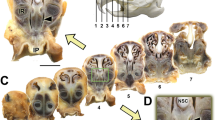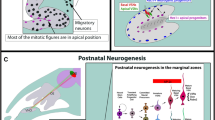Abstract
The present study examined interspecies, intersexual, and age-related changes in size of the vomeronasal neuroepithelium (VNNE) of two species of greater bushbabies (genus Otolemur, Infraorder Lorisiformes, Suborder Strepsirrhini). Tissue blocks containing the vomeronasal organs of nine O. crassicaudatus (8 adults, 1 neonate) and ten O. garnettii (9 adults, 1 neonate) were studied by means of serial paraffin sectioning and computer-based reconstruction of VNNE volume. In addition, the immunoreactivity of the VNNE to two neuronal markers, neuron-specific beta tubulin (BT) and olfactory marker protein (OMP) was compared between species, sexes, and ages. Results indicated that a clear VNNE is present at birth in both species, and OMP immunoreactivity was verified in O. garnettii at birth. Male and female adults of both species showed OMP-immunoreactive and BT-immunoreactive neurons in the VNNE. Immunohistochemical findings indicated that all males and the youngest females had the thickest VNNE, especially at the marginal junctions with the receptor-free epithelium. Results of a 2-way Analysis of Variance (ANOVA, species x sex) revealed no significant differences in VNNE length or volume between species, but O. crassicaudatus had significantly (p < 0.05) greater palatal length. Significant (p < 0.05) differences also were found between sexes in VNNE volume, but no significant differences in palatal length or VNNE length. The distribution of VNNE volume against age indicated that the sex differences were more pronounced in O. crassicaudatus than O. garnettii. For both species and sexes, distribution of VNNE volume against age suggested an age-related reduction in volume. These findings demonstrate postnatal plasticity in VNNE size in Otolemur that is reminiscent of that found for olfactory structures in some rodents. Bushbabies or other strepsirrhine primates may offer an opportunity for further understanding of behavioral correlates of VNNE postnatal plasticity, which may represent primitive functional characteristics of the order Primates.
Similar content being viewed by others
Abbreviations
- BT:
-
beta tubulin
- IHC:
-
immunohistochemistry
- OMP:
-
olfactory marker protein
- RFE:
-
receptor-free epithelium
- VNNE:
-
vomeronasal neuroepithelium
- VNO:
-
vomeronasal organ
- VRN:
-
vomeronasal receptor neurons
References
ABOLMAALI, N. D., KUHNAU, D., KNECHT, M., KOHLER, K., HUTTENBRINK, K. B.& HUMMEL, T.(2001) Imaging of the human vomeronasal duct. Chemical Senses 26, 35–39.
ADDISON, W. H. F. & RADEMAKER, L. A.(1927) The postnatal growth of thevomeronasal organ of the albino rat (Mus norvegicus albinus). Journal of Comparative Neurology 44, 69–86.
AUJARD, F.(1997) Effect of vomeronasal organ removal on malesocio-sexual responses to female in a prosimian primate (Microcebus murinus). Physiology & Behavior 62, 1003–1008.
AUJARD, F.& NEMOZ-BERTHOLET, F. (2004) Response to urinary volatiles andchemosensory function decline with age in a prosimian primate. Physiology &Behavior 81, 639–44.
BHATNAGAR, K. P.& KALLEN, F. C.(1974) Morphology of the nasal cavities andassociated structures in Artibeus jamaicensis and Myotis lucifugus. American Journal of Anatomy 139, 167–189.
BHATNAGAR, K. P.& MEISAMI, E.(1998) Vomeronasal organ in bats andprimates: Extremes of structural variability and its phylogenetic implications. Microscopy Research & Technique 43, 465–475.
BHATNAGAR, K. P., KENNEDY, R. C., BARON, G.& GREENBERG, R. A.(1987)Number of mitral cells and the bulb volume in the aging human olfactory bulb: Aquantitative morphological study. Anatomical Record 218, 73–87.
DAWLEY, E. M.(1998) Species, sex, and seasonal differences in VNO size. Microscopy Research & Technique 41, 506–518.
DAWLEY, E. M.& CROWDER, J.(1995) Sexual and seasonal differences in thevomeronasal epithelium of the red-backed salamander (Plethodon cinereus). Journal of Comparative Neurology 359, 382–390.
DENNIS, J. C., SMITH, T. D., BHATNAGAR, K. P., BURROWS, A. M., BONAR, C. J. & MORRISON, E. E.(2004) Expression of neuron-specific markers by the vomeronasalneuroepithelium in six primates species. Anatomical Record 281A, 1190–1199.
DIXSON, A. F.& VAN HORN, R. N.(1977) Comparative studies of morphologyand reproduction in two subspecies of the greater bushbaby, Galago crassicaudatuscrassicaudatus and G. c. argentatus. Journal of Zoology, London 183, 517–526.
EATON, G. G., SLOB, A.& RESKO, J. A.(1973) Cycles of mating behaviour,estrogen and progesterone in the thick-tailed bushbaby (Galago crassicaudatuscrassicaudatus) under laboratory conditions. Animal Behaviour 21, 309–315.
EVANS., C. & SCHILLING, A.(1995) The accessory (vomeronasal) chemoreceptorsystem in some prosimians. In Creatures of the Dark: The Nocturnal Prosimians. (edited by ALTERMAN, L., DOYLE, G.A.& IZARD, M.K.) pp. 393–411. New York: Plenum.
FARBMAN, A. I.& MARGOLIS, F. L.(1980) Olfactory marker protein duringontogeny: Immunohistochemical localization. Developmental Biology 74, 205–215.
FLEAGLE, J. G.(1999) Primate Adaptation and Evolution. 2nd Edition. San Diego: Academic Press.
GLENDENNING, K. K.& MASTERSON, R. B.(1998) Comparative morphometry ofmammalian central auditory systems: Variation in nuclei and form of the ascending system. Brain, Behavior, & Evolution 51, 59–89.
HALPERN, M., MARTíNEZ-MARCOS, A. (2003) Structure and function of thevomeronasal system: An update. Progress in Neurobiology 70, 245–318.
HEDEWIG, R.(1980a) Vergleichende anatomische untersuchungen an den Jacobsonschen organen von Nycticebus coucang Boddaert, 1785 (Prosimiae, Lorisidae)und Galago crassicaudatus E. Geoffroy, 1812 (Prosimiae, Lorisidae).II.Galago Crassicaudatus. Gegenbaurs Morphologishes Jahrbuche 126, 676–722.
HEDEWIG, R.(1980b) Vergleichende anatomische untersuchungen an den Jacobsonschen organen von Nycticebus coucang Boddaert, 1785 (Prosimiae, Lorisidae)und Galago crassicaudatus. E. Geoffroy, 1812 (Prosimiae, Lorisidae).I. Nycticebus coucang. Gegenbaurs Morphologishes Jahrbuche 126, 543–593.
HINDS, J. W.& McNELLY, N. A.(1977) Aging of the rat olfactory bulb: Growthand atrophy of constituent layers and changes in size and number of mitral cells. Journal of Comparative Neurology 72, 345–367.
HUNTER, A. J., FLEMING, D.& DIXSON, A. F.(1984) The structure of thevomeronasal organ and nasopalatine ducts in Aotus trivirgatus and some other primatespecies. Journal of Anatomy 138, 217–225.
LEE, V. M.& PIXLEY, S. K.(1994) Age and differentiation-relateddifferences in neuron-specific tubulin immunostaining of olfactory sensory neurons. Developmental Brain Research 83, 209–215.
LOO, S. K.& KANAGASUNTHERAM, R.(1972) The vomeronasal organ in tree shrewand slow loris. Journal of Anatomy 112, 165–172.
MAICO, L. M., BURROWS, A. M., MOONEY, M. P., SEIGEL, M. I., BHATNAGAR, K.P.& SMITH, T.D.(2003) Size of the vomeronasal organ in wild Microtus withdifferent mating strategies. Acta Biologica Hungarica 54, 263–273.
MARGOLIS, F. L.(1980) A marker protein for the olfactory chemoreceptorneuron. In Proteins of the Nervous System (edited by BRADSHAW, R. A.&SCHNEIDER, D.) pp. 59–84. New York: Raven.
MARTíNEZ-MARCOS, A., JIA, C., QUAN, W. & HALPERN, M.(2005) Neurogenesis, migration, and apoptosis in the vomeronasal epithelium of adult mice. Journal of Neurobiology 63, 173–187.
MEISAMI, E.(1989) A proposed relationship between increases in the number ofolfactory receptor neurons, convergence ratio and sensitivity in the developing rat. Developmental Brain Research 46, 9–19.
MEISAMI, E., LOUIE, J., HUDSON, R. & DISTEL, H.(1990) A morphometriccomparison of the olfactory epithelium of newborn and weanling rabbits. Cell &Tissue Research 62, 89–97.
MEISAMI, E., MIKHAIL, L., BAIM, D.& BHATNAGAR, K. P.(1998) Humanolfactory bulb: Aging of glomeruli and mitral cells and a search for the accessoryolfactory bulb. Annals of the New York Academy of Sciences 855, 708–715.
MÜLLER, A. E. & THALMANN, U.(2000) Origin and evolution of primatesocial organisation: A reconstruction. Biological Reviews of the Cambridge Philosophical Society 75, 405–435.
NASH, L. T.& HARCOURT, C. S.(1986) Social organization of galagos in Kenyan coastal forests: II: Galago garnettii. American Journal of Primatology 10, 357–369.
NEGUS, V.(1958) The comparative anatomy and physiology of the nose andparanasal sinuses. Edinburgh and London: Livingston.
ROWE, N.(1996) The Pictorial Guide to the Living Primates. Charlestown:Pogonias Press.
SALAZAR I.& SANCHEZ QUINTEIRO, P.(1998) Supporting tissue and vasculatureof the mammalian vomeronasal organ: The rat as a model. Microscopy Research &Technique 41, 492–505.
SCHILLING, A.(1970) L'organe de Jacobson du lemurien malgache Microcebus murinus (Miller, 1977). Memoires du Museum National d'Histoire Naturelle(Serie A) 61, 203–280.
SCHMECHEL, D.E., BURKHART, D.S., ANGE, R.& IZARD, M.K.(1996) Cholinergicaxonal dystrophy and mitochondrial pathology in prosimian primates. Experimental Neurology 142, 111–127.
SEGOVIA, S.& GUILLAMÓN, A. (1982) Effects of sex steroids on thedevelopment of the vomeronasal organ in the rat. Developmental Brain Research 5, 209–212.
SEGOVIA, S.& GUILLAMÓN, A. (1993) Sexual dimorphism in the vomeronasalpathway and sex differences in reproductive behaviors. Brain Research Reviews 18, 51– 74. Review.
SHERWOOD, R. J., McLACHLAN, J. C., AITON, J. F.& SCARBOROUGH, J.(1999)The vomeronasal organ in the human embryo, studied by means of three-dimensional computerreconstruction. Journal of Anatomy 195, 413–418.
SMITH, T. D.& BHATNAGAR, K. P.(2004) Microsmatic primates: Reconsideringhow and when size matters. Anatomical Record 279B, 24–31.
SMITH, T. D., SIEGEL, M. I., MOONEY, M. P., BURDI, A. R.& TODHUNTER, J. S.(1996) Vomeronasal organ growth and development in normal and cleft lip and palatefetuses. Cleft Palate-Craniofacial Journal 33, 385–394.
SMITH, T. D., SIEGEL, M. I., MOONEY, M. P., BURDI, A. R., BURROWS, A. M.& TODHUNTER, J. S.(1997) Prenatal growth of the human vomeronasal organ. Anatomical Record 248, 447–455.
SMITH, T. D., ROSLINSKI, D. L., BURROWS, A. M., BHATNAGAR, K. P., MOONEY, M.P.& SIEGEL, M. I.(2001a) Size of the vomeronasal neuroepithelium in two speciesof Microtus with differing levels of paternal behavior. Journal of Mammalogy82, 209–217.
SMITH, T. D., MOONEY, M. P., BURROWS, A. M., BHATNAGAR, K. P.& SIEGEL, M.I.(2001b) Prenatal growth and adult size of the vomeronasal organ in mouse lemurs andhumans. In Chemical Signals in Vertebrates IX (MARCHLEWSKA-KOJ, A., LEPRI, J.J. &MÜLLER-SCHWARZE, D.) pp. 93–99. New York: Kluwer Academic/Plenum Press.
SMITH, T. D., SHIMP, K. L., BURROWS, A. M., SMITH, M. A.& BHATNAGAR, K. P. (2003) Sexual dimorphism in the vomeronasal organ of Otolemur. American Journalof Physical Anthropology, Supplement 36, 196 (abstract).
SMITH, T. D., BHATNAGAR, K. P., SHIMP, K. L., KINZINGER, J. H., BONAR, C. J.,BURROWS, A. M., MOONEY, M. P.& SIEGEL, M. I.(2002) Histological definition ofthe vomeronasal organ in humans and chimpanzees, with a comparison to other primates. Anatomical Record 267, 166–176.
SOKAL, R. R.& ROHLF, F. J.(1982). Biometry. New York: WH Freeman and Company.
STEPHAN, H., BARON, G.& FRAHM, H. D.(1982) Comparison of brainstructure volumes in Insectivora and Primates. II. Accessory olfactory bulb (AOB). Journal fur Hirnforschung 23, 575–591.
TAKAMI, S.(2002) Recent progress in the neurobiology of the vomeronasalorgan. Microscopy Research & Technique 58, 228–250.
TAI, F. D., WANG, T. Z., ZHANG, Y. H.& SUN, R. Y.(2004) Sexual dimorphismof the vomeronasal organ and the accessory olfactory bulb of the mandarin vole Microtus mandarinus and the reed vole M. fortis. Acta Theriologica 49, 33–42.
THOMPSON, R. N., ROBERTSON, B. K., NAPIER, A.& WEKESA, K. S.(2004)Sex-specific responses to urinary chemicals by the mouse vomeronasal organ. Chemical Senses 29, 749–754.
WATSON, S. L., WARD, J. P., DAVIS, K. B.& STAVISKY, R. C.(1999)Scent-marking and cortisol response in the small-eared bushbaby (Otolemurgarnettii). Physiology & Behavior 66, 695–699.
WEILER, E., McCULLOCH, M. A.& FARBMAN, A. I.(1999a) Proliferation in thevomeronasal organ of the rat during postnatal development. European Journal of Neuroscience 11, 700–711.
WEILER, E., APFELBACH R.& FARBMAN, A. I.(1999b) The vomeronasal organ ofthe male ferret. Chemical Senses 24, 127–136.
WILSON, K. C. P.& RAISMAN, G.(1980) Age-related changes in theneurosensory epithelium of the mouse vomeronasal organ: Extended period of postnatalgrowth in size and evidence for rapid cell turnover in the adult. Brain Research 185, 103–113.
Author information
Authors and Affiliations
Corresponding author
Rights and permissions
About this article
Cite this article
Smith, T.D., Bhatnagar, K.P., Burrows, A.M. et al. The vomeronasal organ of greater bushbabies (Otolemur spp.): Species, sex, and age differences. J Neurocytol 34, 135–147 (2005). https://doi.org/10.1007/s11068-005-5053-9
Received:
Revised:
Accepted:
Issue Date:
DOI: https://doi.org/10.1007/s11068-005-5053-9




